The Queen is easily the strongest piece in the chess game, but the rook comes right after it. Rooks are worth more than bishops and knights because they are more powerful than them, and the best thing about rooks is that their movements are relatively more straightforward or at least simpler than those of bishops and knights.
So, how do rooks move in chess? Rooks move in a straight line, both vertically and horizontally, on a chess board. Rooks cannot move diagonally, or they cannot jump over another pieces except for castling.
Although the movement of rooks is pretty simple and straightforward (literally and figuratively), there is still quite a bit you need to know before you start swinging it around, so in this article, I’m going to explain how rooks move in chess and why it’s actually a very valuable piece.
How chess Pieces Move
Chess has been around for thousands of years, and there is a good chance it will be around for as long as humans survive.
The reason for this is that we are never going to run out of possible chess games. There are literally more possible chess games than there are atoms in the universe.
There are so many possible chess games because of the complex movements of the chess pieces and game rules.
Learning how to move the pieces is one of the first things you learn when starting to play chess, and every chess piece moves in a different way; here is a quick overview:
| Chess Piece | Move Directions | Number of Allowed Steps | Special Moves |
|---|---|---|---|
| King | All Directions | One square only | Castling |
| Queen | All Directions | Any number of squares | None |
| Pawn | In a Straight line, forwards only. Diagonal when capturing an opponent’s piece. | Two steps for its first move, then one step only. | Promotion when it reaches the 8th rank. En Passant Capture of opponent’s pawns. |
| Rook | Straight line only, backward, forwards, left, and right. | Any number of squares. | Castling |
| Knight | In an L-Shape in any direction – | Two squares in any direction followed by one square in the direction vertical to it. | Can jump over other pieces. |
| Bishop | Any Direction diagonally (one the same colour only) | Any number of squares. | None. |
Now that you know basically how all chess pieces move, let’s delve into the intricacies and details of how rooks move on the chess board and what truly makes them this powerful.
How Rooks Move
Rooks move in straight lines in all four directions and as many moves as needed as long as it’s unobstructed by another piece. The rook must have a clear line of movement as it can not leap over other pieces, with one exception we’ll discuss at length later.
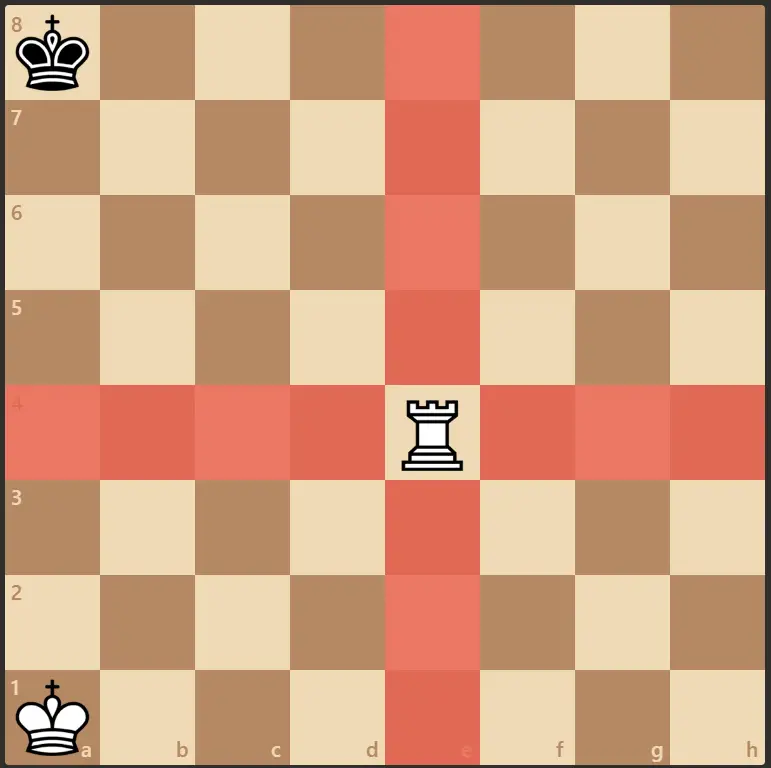
As you can see in the diagram above, all the squares with dots are available for the rook to move to in one move.
The ability to move for any number of moves makes the rooks a very strong piece as it’s one of only three long-range pieces you have in your arsenal (the queen and the bishop are the other two).
This also makes rooks very strong attacking pieces, in particular.
Rooks also capture in the same way, so a rook may capture an opponent’s piece if there is a clear, straight line between the piece and the rook.
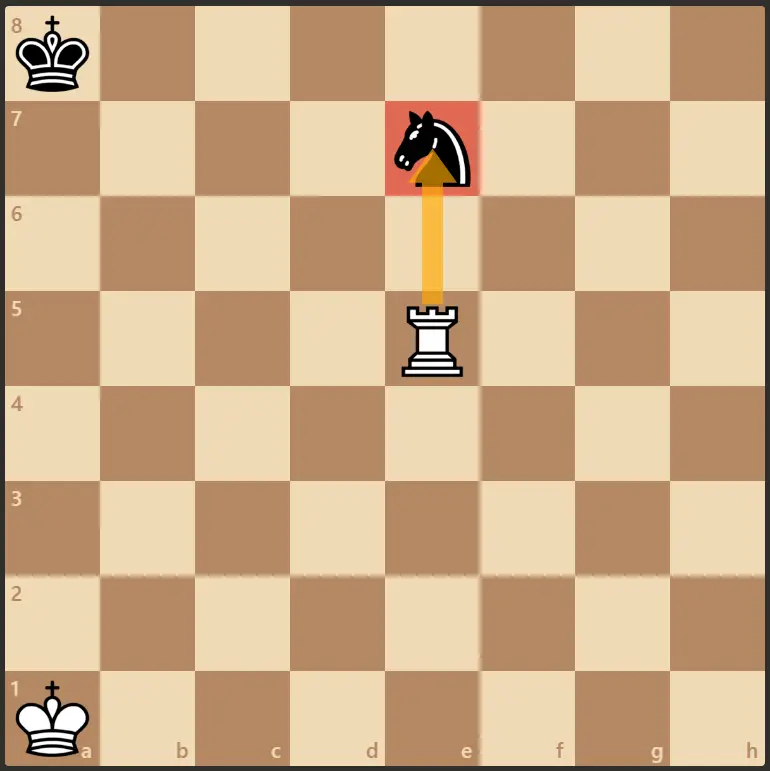
In the diagram above, the rook can capture the knight in one move. So, if it’s white’s turn, the white side can capture the knight.
Rooks, Don’t Jump over other pieces.
An important note is that rooks do not jump over other pieces except their own king when castling.
The only piece that can jump over other pieces is the knight. Now that we’ve mentioned castling. Let’s see what this is all about.
How Rooks Move when Castling
The only case where a rook will jump over another piece is when castling. A common mistake/misconception with new chess players is that the king and rook switch places when castling, which is incorrect.
Castling kingside and queenside are very similar, and they follow the same rules.
Here are the rules of castling:
- The king has not moved before
- The Rook has not moved before
- The king is not in check
- The squares between the rook and the king are unoccupied
- None of the squares between the rook and the king are in check
These rules are pretty simple. Now, let’s look at how Castling works.
How does Castling work?
There are two types of castling in Chess:
- Castling kingside
- Castling queenside
In most of your games, you will be castling kingside. It’s safer, easier, and faster (fewer squares to clear before castling, and it’s often faster to move the kingside pieces than the queenside’s).
Castling works by moving the king two squares to either side of the board, and then the rook will jump over the king and sit in the square right next to it (but now on the other side of the side it was originally on).
Castling Kingside VS Queenside
From the perspective of the rook, the difference between castling kingside and queenside is in the number of squares the rook will move in each case.
While the king will always move two squares over when castling in either direction, the rook will move:
- Two squares with kingside castling
- Three squares with kingside castling.
Castling Kingside Illustration
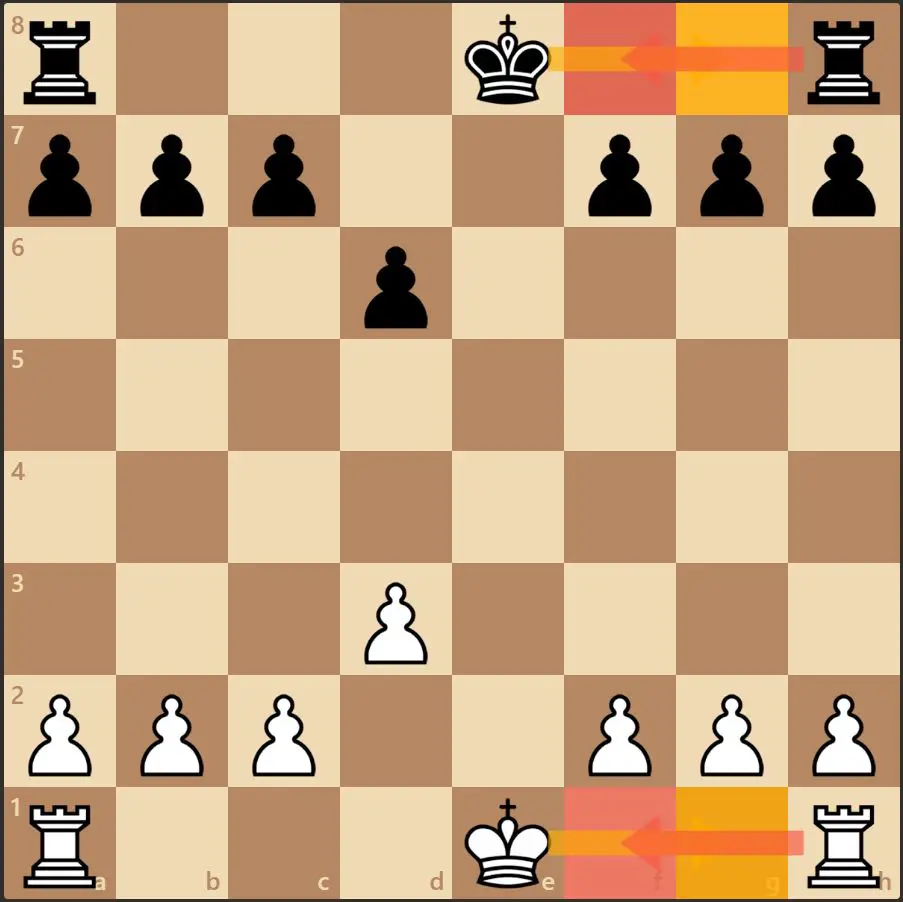
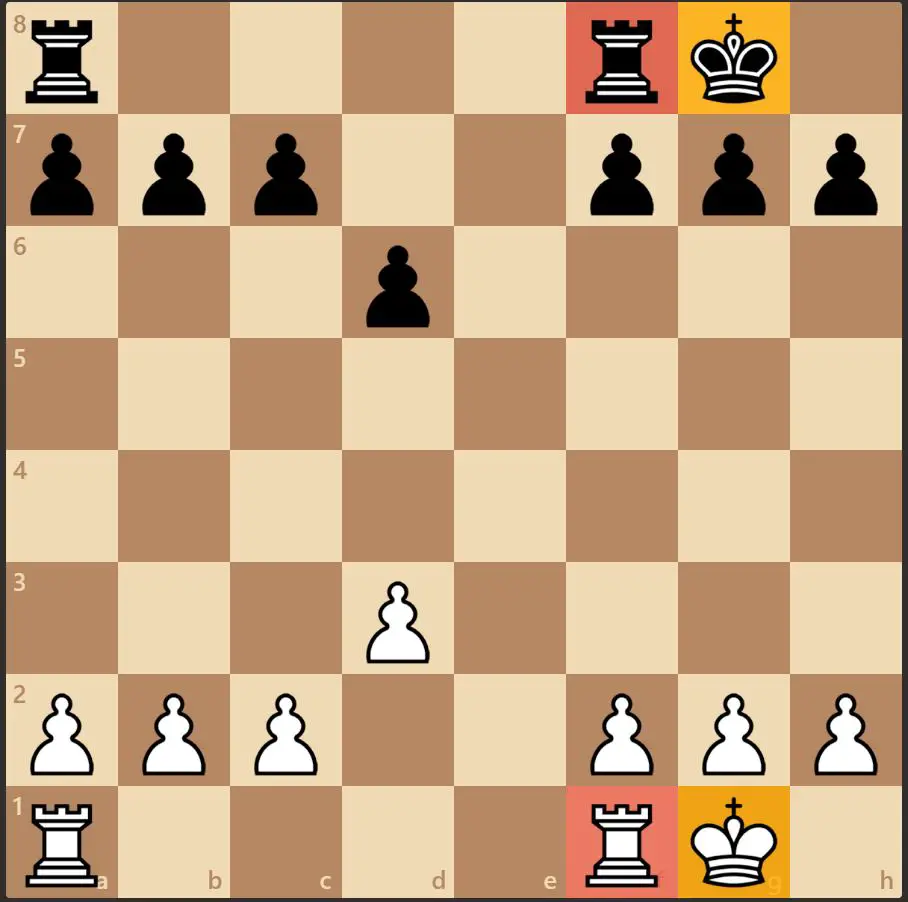
Castling kingside is very straightforward. The king moves two steps in the right direction and moves from its original position of e1 to the new square of g1, and the rook also moves two squares, jumping over the king to end up in its new position of f1.
Castling Queenside Illustration:
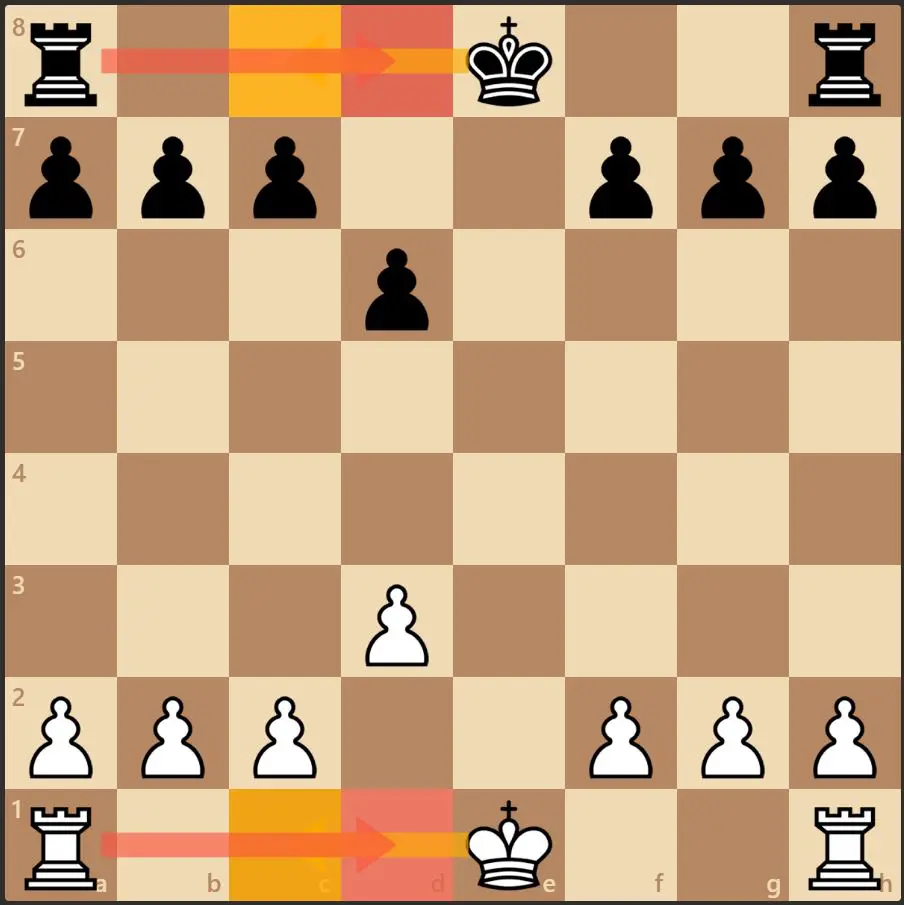
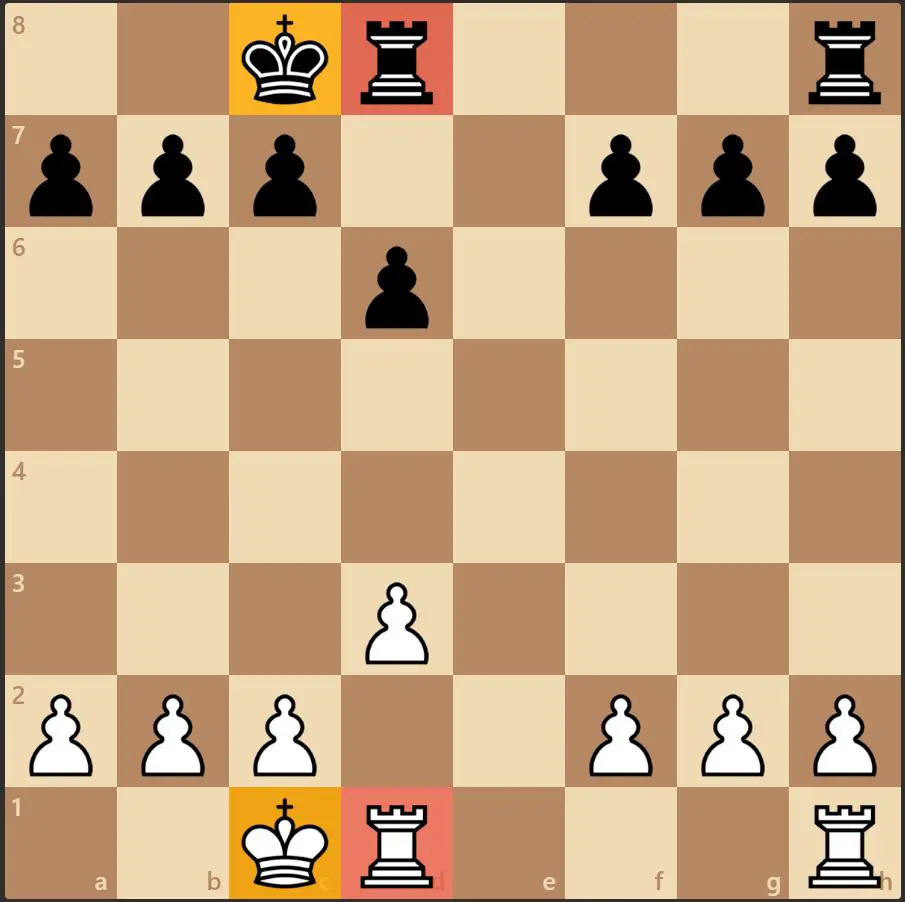
As you can see in the image above, when castling Queenside, the king moves from its original square (e1) to its new position of C1, while the queenside’s rook moves from its original position of a1 to the new position of d1, jumping over the king in the process.
You should note how the king still moved only two squares while the rook moved three squares to still end up in the square right next to the king.
The different symbols for each castling type
To distinguish between castling kingside and Queenside, they each have a different symbol that you must use in your scoresheet.
The symbol for Castling Kingside is: O-O
The symbol for Castling Queenside is: O-O-O
If you get confused, just remember that the shorter symbol is for castling in the shorter direction, which is the kingside. You can learn more in our Chess Notations guide .
.
The Value of a Rook
The value of rook in chess is 5 points, or equal to 5 pawns (since a pawn is worth only 1 point). This makes it more valuable than bishops and knights (both valued at 3 points or 3 pawns) but about two points.
The value of the rook is rather peculiar when compared to the values of other chess pieces. It’s not exactly worth two knights or two bishops, but two rooks are also worth more than a queen.
One more note I should add here is that there is some controversy in the chess world regarding the numerical value of knights, with some claiming that a knight should be valued at 3.5, making it half a point more valuable than the bishop, but It’s doubtful that these claims will change the standard anytime soon.
You can learn more about how Bishops and knights differ in our Bishops vs. knights guide.
guide.
Regardless, it’s worth remembering that a piece’s value is not in numbers but rather in its impact on the game and influence over the position, which is always relative to the position.
Why Rooks are more valuable than Bishops and Knights
There are two main reasons why rooks are more valuable (and important) than bishops and knights.
- Rooks are more powerful than both bishops and knights
- A rook on its own can deliver a checkmate, while neither a knight nor a bishop can deliver a checkmate alone
Even two knights with the king cannot force a checkmate, but two bishops can, although it’s very tricky for amateurs to execute.
How to make your Rook stronger
Your rook is worth exactly nothing if it’s trapped behind your pawns or surrounded by your pieces. Rooks are strong pieces that can move in any direction. Thankfully, there are some easy ways to help your rooks become stronger:
Bring them to the center
In the center, your rooks have more reach and can protect your position more effectively.
It can also influence more squares, taking them away from your opponent and putting them under your control.
The easiest way to bring your rooks to the center is, of course, to castle, which also adds the benefit of bringing your king to safety.
Lift them
Lifting your rooks is one of the best ways to bring them into the fight. If you can’t move your pawns to open up the file for your rook, you can instead lift your rook to bring it in front of the pawn.
For example, in the position below, you can take the bishop with the rook instead of the Queen with the intention to bring it into the H file to attack the king:
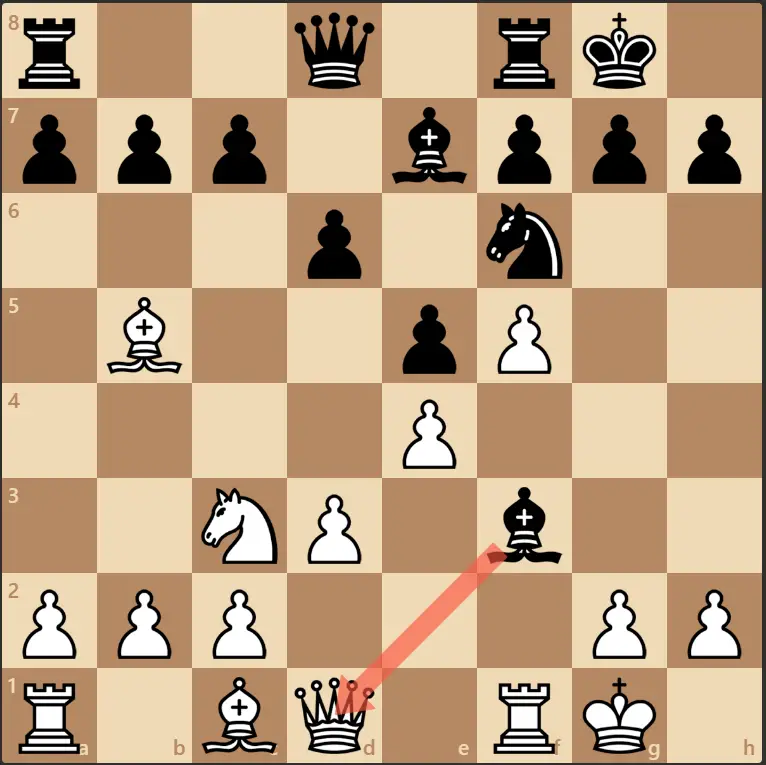
So, while most people would play Qxf3 without hesitation here, I would probably play Rxf3 with the intention that after they respond with Nd4, forking both the rook and the Bishop, simply move the rook to the h file aiming the h7 pawn.
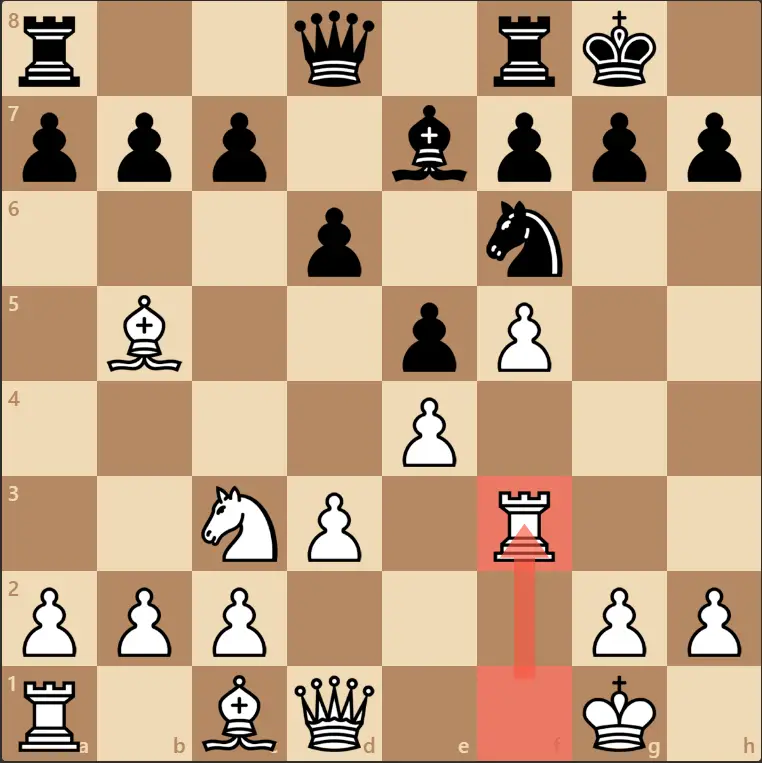
In this position, I don’t mind losing the white bishop since all my pawns are on white squares, making it a weak piece anyway.
It’s often simple to bring the queen into the fight, so when I have the choice between bringing either of them, I would bring the rook as I don’t know if Black would take away the f3 square from me later in the game, taking away this possibility.
Open up the position
Rooks love open files, so if you want to make your rooks stronger, you should try to open up the position by exchanging pawns or lighter pieces so they have more freedom to move around the board.
by exchanging pawns or lighter pieces so they have more freedom to move around the board.
Bring them to the 7th Rank
Rooks are particularly strong on the 7th rank. Note that whenever we say “7th rank”, we mean the 7th rank from your side, so it may be the 2nd or 7th Row on the board depending on which side you are playing.
Why are rooks so powerful on the 7th rank? For two main reasons:
- There are usually a few pawns there with little to no protection that can take
- They severely restrict the opponent’s pieces and trap their king
I gotta tell you, I’ve had some opponents control the 7th rank with their rooks, and it was a painful loss every time.
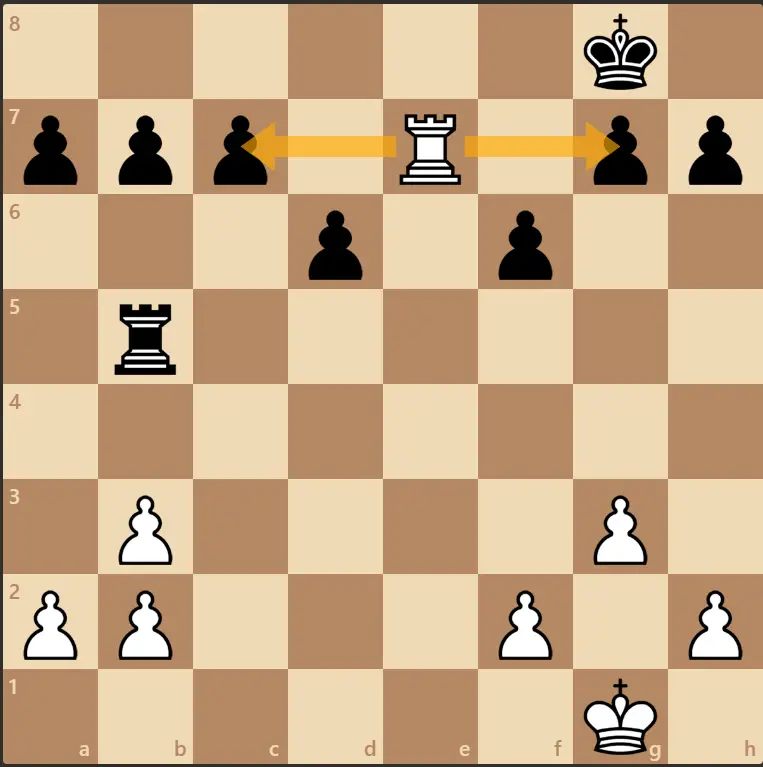
Can you see how the white rook does three fantastic jobs in this position by being on the 7th rank?
- Threatening all the pawns on the 7th rank
- Trapping the black king in the 8th rank
- Restricting the black rook movement as it needs to protect the pawns under attack, instead of attacking white’s pawns itself
Support them with Knights
Rooks are heavy hitters, but they still could use the support of lighter pieces. Knights and rooks work particularly well together, and there are some pretty fantastic checkmating patterns with the rook and knight combination.
Use them to support pawns with a clear path to promotion
Because rooks are long-distance hitters, they are also long-distance protectors.
A rook is the passed pawn’s best friend, and by the way, a passed pawn is what we call a pawn on a clear file with no other piece or pawn obstructing its way to promotion.
The Famous Backrank Checkmate
The Back Rank checkmate is one of the many reasons a rook is a very strong piece.
The back rank checkmate is one of the most common beginner’s mistakes in chess and one of the most popular mating patterns and threats used in games of all levels.
Here is a simplified illustration of the back rank checkmate:

In the example above, Re8# wins the game.
There are many famous games that ended with a back rank checkmate. Despite its simplicity, even masters sometimes overlook the back rank checkmate pattern.
Conclusion
Rooks move in a simple and straightforward way. They can move along files and rows in straight lines and travel as many squares as they need as long as they are unobstructed, which is the key to their value.
Because they are long-distance hitters, you should always try to put them in open files where they can exert their control on more squares. Rooks are also better as attackers than defenders.
Related Questions
Can rooks move backwards?
Rooks can move backwards any number of squares in one move as long as there are no other pieces in the way. Rooks, like all other chess pieces with the exception of pawns, can move in all 4 directions as long as it’s legal.
Can Rooks Move diagonally?
Rooks can not move diagonally. Rooks can only move in straight lines forward, backward, left, and right and they can move any number of moves in one turn as long as it’s legal. The Bishop is the piece that moves diagonally but only on one color, but the queen and king can also move diagonally on any square color.
What is another name for a rook in Chess?
The rook was also called the tower, the rector, and the marquess. The name rook comes from the Persian word Rukh, which means the chariot piece. When Chess moved into Europe, the Italian name “Rocca” caught on for the piece, which means Castle, and henceforth the current design.
